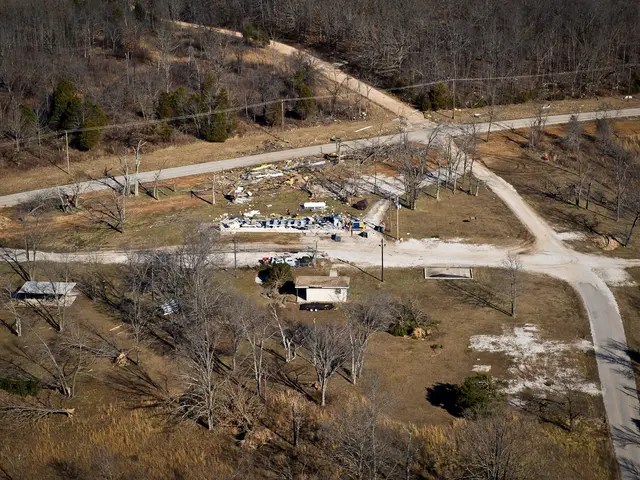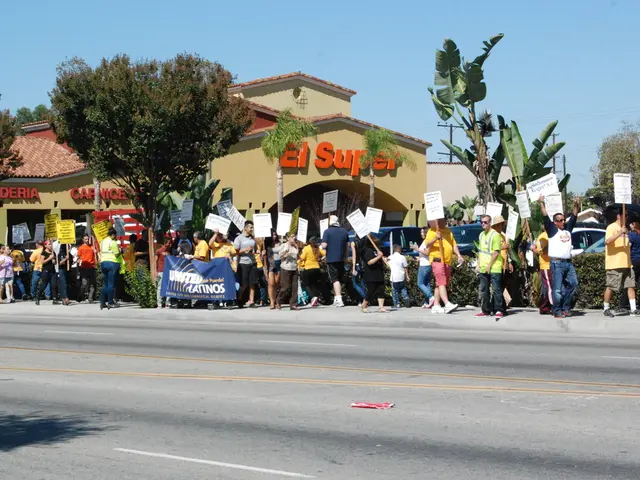"Individuals go without food for a duration of three to four days"
Crisis in Gaza: Over Half a Million People Face Famine-like Conditions
The situation in Gaza, as viewed by the UN World Food Programme (WFP), is dire. Over 500,000 people are currently facing famine-like conditions, including more than 320,000 children under five who are at risk of acute malnutrition. Food consumption has plummeted, with about 39% of the population going days without eating, and malnutrition rates among children have quadrupled in just two months, reaching alarmingly high levels.
The conflict, widespread displacement, infrastructure collapse, and severe restrictions on humanitarian aid delivery have created catastrophic food insecurity. Families are surviving on as little as 245 calories per day, barely 12% of their daily nutritional needs. Thousands of children have been hospitalized for severe acute malnutrition, highlighting the critical nature of the crisis.
To alleviate this hunger crisis, WFP has been delivering large-scale food aid since the conflict escalated in October 2023. They are feeding around 1.3 million people (over half the population) with fresh bread, canned foods, and ready-to-eat meals. However, access remains severely restricted, and aid deliveries face constant risks and logistical challenges. WFP currently has enough food to feed the entire Gaza population for nearly three months, but rapid and sustained access is essential.
The WFP is advocating for unrestricted humanitarian access, removal of blockades, improved facilitation from all parties, including Israel, to increase the number of aid convoys, use alternative routes, and ensure safe passage without military interference. An agreed ceasefire is also emphasized as the only viable way to ensure aid reaches all civilians across Gaza in a predictable and secure manner.
Before the conflict, two-thirds of the Gaza population already lacked sufficient food. In March 2024, the Integrated Food Security Phase Classification found that the entire population of Gaza was going hungry, with around 500,000 people on the brink of famine. The Israeli offensive caused chaos in Gaza, leading to people fleeing their homes and seeking shelter.
Since May 21st, Israel has been allowing humanitarian aid to pass through, but not in the required quantities. WFP has 170,000 tons of food ready outside the Gaza Strip, enough to feed the population for two months. However, a minimum of 100 trucks per day on the land route into the Gaza Strip is immediately needed to bring in the enormous amount of food necessary to avert a famine.
Many people in Gaza complain that nothing reaches them, and a kilo of flour is being sold for 23 euros in the market. The unloading and inspection of cargo by Israeli authorities can sometimes take two days due to slow approval processes. Videos on the internet show armed looters driving around with trucks full of humanitarian aid in Gaza. Despite this, the Israeli army has publicly stated that there is no systematic diversion of World Food Programme aid supplies.
WFP is bringing in high-energy food specifically for infants, breastfeeding mothers, and pregnant women in Gaza to prevent the worst effects of malnutrition. Martin Frick, Germany director of WFP, states that the situation in Gaza is very clear and the population is going hungry. The UN World Food Programme (WFP) is one of the largest sources of food for people in Gaza, with over two million people who are acutely hungry. Without immediate and sustained action, starvation, malnutrition-related deaths, and irreversible hunger impacts on children and vulnerable populations will continue to worsen.
References:
- UN World Food Programme
- Reuters
- Al Jazeera
- The Guardian
- BBC News
- The World Food Programme (WFP) emphasizes the urgent need for community policy changes to ensure the free movement of workers, aiding in the distribution of humanitarian aid in Gaza.
- In addition, the freedom of movement of workers is crucial for the efficient operation of WFP and other aid organizations in Gaza.
- The freedom to provide services, such as medical care, is paramount for addressing the health crises faced by the population in Gaza.
- According to workplace-wellness experts, addressing the mental-health needs of aid workers in Gaza is essential for maintaining the delivery of critical services.
- WFP has reported cases of chronic diseases and cance among its staff members working in Gaza, highlighting the importance of medical-conditions screening and support.
- Respiratory-conditions and other health issues linked to poor air quality are prevalent in Gaza; therefore, promoting fitness-and-exercise and cleanliness in the workplace can help safeguard employee health.
- Eye-health and hearing are vital aspects of worker well-being in Gaza, requiring appropriate resources and support from WFP and other organizations.
- Ensuring access to health-and-wellness resources, including nutrition, is a top priority for WFP in Gaza, where malnutrition rates among children are at alarmingly high levels.
- To further support the overall health of the community in Gaza, WFP should prioritize skin-care, targeted therapies-and-treatments, and addressing sexual-health concerns.
- Autoimmune-disorders and mental-health issues are common among the Gaza population and must be considered when designing community policy for the well-being of workers.
- Men's health initiatives and services should also be incorporated into community policy in Gaza to address gender-specific health concerns.
- WFP should collaborate with skin-care experts to develop skincare education programs and provide skin-care products to help combat skin conditions that are prevalent in Gaza.
- Proper wealth-management resources can empower Gaza's workers to create sustainable livelihoods and contribute to the local economy.
- Businesses and financial institutions should prioritize policies that promote financial inclusion and access to finance for Gaza's small-scale entrepreneurs.
- Personal-finance education should be integrated into WFP's workplace wellness programs to help workers make informed decisions about money management.
- With education-and-self-development opportunities being limited in Gaza, WFP should partner with organizations to offer personal-growth workshops and career-development resources.
- Job-search assistance, skills-training programs, and learning resources can help equip Gaza's workers with the tools they need to secure employment opportunities.
- To improve overall community well-being, WFP should prioritize sports programs and facilities in Gaza to promote physical fitness and social cohesion.
- Introducing sports such as football, soccer, basketball, and baseball to Gaza can provide children and youth with healthy outlets for recreation and stress relief.
- By funding WNBA, NBA, MLB, NHL, golf, NCAA basketball, racing, and American football teams in Gaza, WFP can create employment opportunities and encourage community engagement.
- Horse-racing, tennis, auto-racing, and mixed-martial-arts are other sports that could be integrated into community programs in Gaza to foster economic growth and social development.
- Addressing grand-prix, horse-racing, and other large-scale sports events can potentially generate revenue for Gaza's local economy and foster international collaboration.
- Expanding the focus of WFP's programs in Gaza to include sports, personal finance, and career development can create a more holistic approach to community well-being.
- WFP should also collaborate with organizations to establish nutrition education and weight-management initiatives in Gaza to combat obesity and improve overall health.
- In addition to food support, addressing cardiovascular-health concerns in Gaza is essential for reducing the risk of heart disease and other chronic conditions.
- WFP should advocate for medicare policies that ensure accessible and affordable healthcare for Gaza's most vulnerable populations.
- The integration of CBD products and therapies into WFP's programs could help alleviate the symptoms of neurological-disorders and mental-health issues faced by the Gaza population.
- Moving forward, WFP should prioritize ongoing monitoring and evaluation of its programs in Gaza to ensure their effectiveness and make data-driven decisions for program improvements.
- WFP's efforts to alleviate the hunger crisis in Gaza will require long-term commitment, addressing not only food security but also education, economic development, and health-and-wellness needs.







